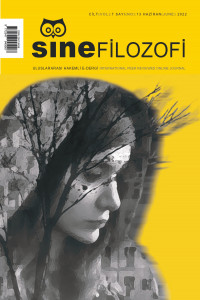An Exceptional Adam and Eve Story Through Gilles Deleuze’s Concept of Crystal-Image: The Fountain (2006)
An Exceptional Adam and Eve Story Through Gilles Deleuze’s Concept of Crystal-Image: The Fountain (2006)
Author(s): Filiz Erdoğan Tuğran, Aytaç Hakan TuğranSubject(s): Transformation Period (1990 - 2010), Film / Cinema / Cinematography, Sociology of Art
Published by: Serdar Öztürk
Keywords: Time-Image; Cyristal-Image; Gilles Deleuze; Henri Bergson; Darren Aronofsky;
Summary/Abstract: The concept of motion-image, which is one of Gilles Deleuze’s important concepts about cinema, is identified with Hollywood films. The organic fiction structure, the linear narrative of the story, the situations the movie characters are in, the actions they take, these actions and situations transforming each other and reaching a conclusion, and presenting all these in a way that is suitable for the sensorymotor are seen as elements included in the definition of movement-image. Although all these justify the identification of motion-image cinema with Hollywood cinema, there are also films that are contrary to this conventional structure in terms of some elements. One of these films is The Fountain, directed by Darren Aronofsky in 2006. The film takes love at the center of three interrelated and interlocking stories. With these three stories, fed from different time periods and mythological elements, the feeling of Love surrounds the entire filmic universe. The possibility of the main protagonists to turn into Adam and Eve, which becomes evident in the middle of the first story told in the movie, will make the love theme in the movie similar to the love in creation, and thus the story will be related to a situation where love is related to a superhuman cosmos rather than the love between two people. This film, which differs from the traditional plot and produces exceptions and forkings, will be considered together with Deleuze’s concept of time-image. Time-image cinema can be described as an order of images that are far from linear narration, make the audience think together with the hero, and break their sensory-motor mechanism. In the article, The Fountain (2006) movie will be considered together with the time-image cinema and the crystal-image concept, which is one of its important images regime. The crystal-image presents different possibilities and reflections of the same images as the faces of the crystal. Three different stories told throughout the movie are considered as different reflections and different surfaces of the lives of the same heroes. Based on these reflections in The Fountain (2006), the possibilities of revealing a direct time image will be examined based on the peaks of present, and the sheets of past which are seen as the symptoms of the crystal-image.
Journal: SineFilozofi
- Issue Year: 7/2022
- Issue No: 13
- Page Range: 45-60
- Page Count: 16
- Language: English

